Study on the Spatiotemporal Heterogeneity and Threshold Effects of Ecosystem Services in Honghe Prefecture, Yunnan Province
Abstract
1. Introduction
2. Materials and Methods
2.1. Study Area
2.2. Data Sources
2.3. Assessment of Ecosystem Services
2.4. Measurement of the Interplay of Trade-Offs and Synergies Between Pairs of ESs
2.4.1. Intercorrelation of ES Groups
2.4.2. Geographically Weighted Regression
2.5. Identification of ES Bundles
2.6. Construction of a Comprehensive Ecosystem Service Index
2.7. Driving Factors and Their Threshold Effects
2.7.1. Natural–Social Factor Selection
2.7.2. Relative Importance Assessment
2.7.3. Threshold Effect Evaluation
3. Results
3.1. Spatial and Temporal Variances in Ecosystem Services
3.1.1. Difference in ESs’ Spatial–Temporal Patterns
3.1.2. Difference in Spatial–Temporal Patterns of the ESI
3.2. Differences in Trade-Offs and Synergies of ESs at Different Scales
3.2.1. Trade-Offs and Synergies of ES Pairs
3.2.2. Spatial and Temporal Characteristics of Trade-Offs and Synergies of ESs
3.3. The Identification of ES Bundles at Different Temporal and Spatial Scales
- (1)
- FP bundle (Bi): This particular bundle was predominantly found in the central and northern sectors of the research locale. The land use type was mainly cropland. It accounted for 16.92%, 19.41%, and 23.14% of the study area in 2000, 2010, and 2020, respectively (Figure 9a,c). This bundle exhibited a spatial collaborative feature of high FP (Figure 9b).
- (2)
- HQ-CS key synergy bundle (Bii): This bundle predominantly occupied the northwestern and northeastern regions of the study area in 2000, and it was predominantly characterized by forested land, which constituted 15.68% of the total area under investigation. By 2010 and 2020, the distribution of this bundle had shifted predominantly to the northwestern and southwestern parts, representing an increased proportion of the study area at 39.67% and 40.60% (Figure 9a,c). Notably, this bundle demonstrated a spatial synergy with high levels of both HQ and CS (Figure 9b).
- (3)
- Integrated ecosystem bundle (Biii): This bundle was notably concentrated in the southern mountainous regions of the study area in 2000, accounting for 44.75% of the study area. However, in 2010 and 2020, it was mainly distributed in the southeast, accounting for 11.28% and 5.08% of the study area, respectively (Figure 9a,c). This bundle was characterized by providing multiple ESs, including HQ, SC, CS, and WY (Figure 9b).
- (4)
- Ecological transition bundle (Biv): In 2000, 2010, and 2020, this bundle was mainly distributed in the transition zone between different bundles, accounting for 22.64%, 29.64%, and 31.19% of the research area, respectively (Figure 9a,c). This bundle showed the characteristics of low ES and frequent changes with other bundles (Figure 9b,c).
3.4. Threshold Effect of the ESI
4. Discussion
4.1. Spatial–Temporal Patterns of ES Supply and Their Interactions
4.2. The Threshold Effect of the ESI’s “Natural–Social” Driving Factors
4.3. The Spatial Scale Effect of ES Interactions
4.4. Multi-Scale Management of Regional ESs Based on the Perspective of “Supply–Interaction–Drive–Threshold”
4.5. Limitations and Prospects of Research
5. Conclusions
Supplementary Materials
Author Contributions
Funding
Data Availability Statement
Conflicts of Interest
References
- Abernethy, V.D. Nature’s Services: Societal Dependence on Natural Ecosystems. Popul. Environ. 1999, 20, 277–278. [Google Scholar] [CrossRef]
- Bennett, E.M.; Peterson, G.D.; Gordon, L.J. Understanding Relationships among Multiple Ecosystem Services. Ecol. Lett. 2009, 12, 1394–1404. [Google Scholar] [CrossRef]
- Zhang, Z.; Liu, Y.; Wang, Y.; Liu, Y.; Zhang, Y.; Zhang, Y. What Factors Affect the Synergy and Tradeoff between Ecosystem Services, and How, from a Geospatial Perspective? J. Clean. Prod. 2020, 257, 120454. [Google Scholar] [CrossRef]
- Shen, J.; Li, S.; Liu, L.; Liang, Z.; Wang, Y.; Wang, H.; Wu, S. Uncovering the Relationships between Ecosystem Services and Social-Ecological Drivers at Different Spatial Scales in the Beijing-Tianjin-Hebei Region. J. Clean. Prod. 2021, 290, 125193. [Google Scholar] [CrossRef]
- Wang, C.; Tang, C.; Fu, B.; Lü, Y.; Xiao, S.; Zhang, J. Determining Critical Thresholds of Ecological Restoration Based on Ecosystem Service Index: A Case Study in the Pingjiang Catchment in Southern China. J. Environ. Manag. 2022, 303, 114220. [Google Scholar] [CrossRef] [PubMed]
- Liu, L.; Zhang, H.; Gao, Y.; Zhu, W.; Liu, X.; Xu, Q. Hotspot Identification and Interaction Analyses of the Provisioning of Multiple Ecosystem Services: Case Study of Shaanxi Province, China. Ecol. Indic. 2019, 107, 105566. [Google Scholar] [CrossRef]
- Wu, L.; Fan, F. Assessment of Ecosystem Services in New Perspective: A Comprehensive Ecosystem Service Index (CESI) as a Proxy to Integrate Multiple Ecosystem Services. Ecol. Indic. 2022, 138, 108800. [Google Scholar] [CrossRef]
- Zhu, Q.; Cai, Y. Integrating Ecological Risk, Ecosystem Health, and Ecosystem Services for Assessing Regional Ecological Security and Its Driving Factors: Insights from a Large River Basin in China. Ecol. Indic. 2023, 155, 110954. [Google Scholar] [CrossRef]
- Liu, Q.; Qiao, J.; Li, M.; Huang, M. Spatiotemporal Heterogeneity of Ecosystem Service Interactions and Their Drivers at Different Spatial Scales in the Yellow River Basin. Sci. Total Environ. 2024, 908, 168486. [Google Scholar] [CrossRef] [PubMed]
- Meacham, M.; Norstrom, A.; Peterson, G.D.; Andersson, E.; Bennett, E.M.; Biggs, R.; Crouzat, E.; Cord, A.F.; Enfors, E.; Felipe-Lucia, M.R.; et al. Advancing Research on Ecosystem Service Bundles for Comparative Assessments and Synthesis. Ecosyst. People 2022, 18, 99–111. [Google Scholar] [CrossRef]
- Raudsepp-Hearne, C.; Peterson, G.D.; Bennett, E.M. Ecosystem Service Bundles for Analyzing Tradeoffs in Diverse Landscapes. Proc. Natl. Acad. Sci. USA 2010, 107, 5242–5247. [Google Scholar] [CrossRef] [PubMed]
- Harris, L.R.; Defeo, O. Sandy Shore Ecosystem Services, Ecological Infrastructure, and Bundles: New Insights and Perspectives. Ecosyst. Serv. 2022, 57, 101477. [Google Scholar] [CrossRef]
- Feng, Q.; Zhao, W.; Hu, X.; Liu, Y.; Daryanto, S.; Cherubini, F. Trading-off Ecosystem Services for Better Ecological Restoration: A Case Study in the Loess Plateau of China. J. Clean. Prod. 2020, 257, 120469. [Google Scholar] [CrossRef]
- Qin, K.; Li, J.; Yang, X. Trade-Off and Synergy among Ecosystem Services in the Guanzhong-Tianshui Economic Region of China. Int. J. Environ. Res. Public Health 2015, 12, 14094–14113. [Google Scholar] [CrossRef]
- Stosch, K.C.; Quilliam, R.S.; Bunnefeld, N.; Oliver, D.M. Quantifying Stakeholder Understanding of an Ecosystem Service Trade-Off. Sci. Total Environ. 2019, 651, 2524–2534. [Google Scholar] [CrossRef] [PubMed]
- Kong, L.; Zheng, H.; Xiao, Y.; Ouyang, Z.; Li, C.; Zhang, J.; Huang, B. Mapping Ecosystem Service Bundles to Detect Distinct Types of Multifunctionality within the Diverse Landscape of the Yangtze River Basin, China. Sustainability 2018, 10, 857. [Google Scholar] [CrossRef]
- Cai, W. Identifying Ecosystem Services Bundles for Ecosystem Services Trade-Off/Synergy Governance in an Urbanizing Region. Land 2022, 11, 1593. [Google Scholar] [CrossRef]
- Cheng, X.; Xu, Z.; Yu, S.; Peng, J. A Wavelet Coherence Approach to Detecting Ecosystem Services Trade-off Response to Land Use Change. J. Environ. Manag. 2022, 316, 115160. [Google Scholar] [CrossRef]
- Peng, J.; Tian, L.; Liu, Y.; Zhao, M.; Hu, Y.; Wu, J. Ecosystem Services Response to Urbanization in Metropolitan Areas: Thresholds Identification. Sci. Total Environ. 2017, 607, 706–714. [Google Scholar] [CrossRef] [PubMed]
- Ma, S.; Wang, L.-J.; Jiang, J.; Chu, L.; Zhang, J.-C. Threshold Effect of Ecosystem Services in Response to Climate Change and Vegetation Coverage Change in the Qinghai-Tibet Plateau Ecological Shelter. J. Clean. Prod. 2021, 318, 128592. [Google Scholar] [CrossRef]
- Wu, J.; Guo, X.; Zhu, Q.; Guo, J.; Han, Y.; Zhong, L.; Liu, S. Threshold Effects and Supply-Demand Ratios Should Be Considered in the Mechanisms Driving Ecosystem Services. Ecol. Indic. 2022, 142, 109281. [Google Scholar] [CrossRef]
- Ran, Z.; Gao, S.; Zhang, B.; Guo, C.; Ouyang, X.; Gao, J. Non-Linear Effects of Multi-Dimensional Urbanization on Ecosystem Services in Mega-Urban Agglomerations and Its Threshold Identification. Ecol. Indic. 2023, 154, 110846. [Google Scholar] [CrossRef]
- Cord, A.F.; Bartkowski, B.; Beckmann, M.; Dittrich, A.; Hermans-Neumann, K.; Kaim, A.; Lienhoop, N.; Locher-Krause, K.; Priess, J.; Schroeter-Schlaack, C.; et al. Towards Systematic Analyses of Ecosystem Service Trade-Offs and Synergies: Main Concepts, Methods and the Road Ahead. Ecosyst. Serv. 2017, 28, 264–272. [Google Scholar] [CrossRef]
- Zheng, D.; Wang, Y.; Hao, S.; Xu, W.; Lv, L.; Yu, S. Spatial -Temporal Variation and Tradeoffs/Synergies Analysis on Multiple Ecosystem Services: A Case Study in the Three -River Headwaters Region of China. Ecol. Indic. 2020, 116, 106494. [Google Scholar] [CrossRef]
- Lautenbach, S.; Kugel, C.; Lausch, A.; Seppelt, R. Analysis of Historic Changes in Regional Ecosystem Service Provisioning Using Land Use Data. Ecol. Indic. 2011, 11, 676–687. [Google Scholar] [CrossRef]
- Deng, X.; Li, Z.; Gibson, J. A Review on Trade-off Analysis of Ecosystem Services for Sustainable Land-Use Management. J. Geogr. Sci. 2016, 26, 953–968. [Google Scholar] [CrossRef]
- Raudsepp-Hearne, C.; Peterson, G.D. Scale and Ecosystem Services: How Do Observation, Management, and Analysis Shift with Scale-Lessons from Quebec. Ecol. Soc. 2016, 21, 16. [Google Scholar] [CrossRef]
- Li, M.; Zheng, P.; Pan, W. Spatial-Temporal Variation and Tradeoffs/Synergies Analysis on Multiple Ecosystem Services: A Case Study in Fujian. Sustainability 2022, 14, 3086. [Google Scholar] [CrossRef]
- Liao, C.; Yue, Y.; Wang, K.; Fensholt, R.; Tong, X.; Brandt, M. Ecological Restoration Enhances Ecosystem Health in the Karst Regions of Southwest China. Ecol. Indic. 2018, 90, 416–425. [Google Scholar] [CrossRef]
- Tong, X.; Wang, K.; Yue, Y.; Brandt, M.; Liu, B.; Zhang, C.; Liao, C.; Fensholt, R. Quantifying the Effectiveness of Ecological Restoration Projects on Long-Term Vegetation Dynamics in the Karst Regions of Southwest China. Int. J. Appl. Earth Obs. Geoinf. 2017, 54, 105–113. [Google Scholar] [CrossRef]
- Peng, J.; Yang, Y.; Liu, Y.; Hu, Y.; Du, Y.; Meersmans, J.; Qiu, S. Linking Ecosystem Services and Circuit Theory to Identify Ecological Security Patterns. Sci. Total Environ. 2018, 644, 781–790. [Google Scholar] [CrossRef] [PubMed]
- Zhang, W.; Yu, Y.; Wu, X.; Pereira, P.; Borja, M.E.L. Integrating Preferences and Social Values for Ecosystem Services in Local Ecological Management: A Framework Applied in Xiaojiang Basin Yunnan Province, China. Land Use Pol. 2020, 91, 104339. [Google Scholar] [CrossRef]
- Sun, X.; Lu, Z.; Li, F.; Crittenden, J.C. Analyzing Spatio-Temporal Changes and Trade-Offs to Support the Supply of Multiple Ecosystem Services in Beijing, China. Ecol. Indic. 2018, 94, 117–129. [Google Scholar] [CrossRef]
- Pan, H.; Du, Z.; Wu, Z.; Zhang, H.; Ma, K. Assessing the Coupling Coordination Dynamics between Land Use Intensity and Ecosystem Services in Shanxi’s Coalfields, China. Ecol. Indic. 2024, 158, 111321. [Google Scholar] [CrossRef]
- Zhang, S.; Xiong, K.; Qin, Y.; Min, X.; Xiao, J. Evolution and Determinants of Ecosystem Services: Insights from South China Karst. Ecol. Indic. 2021, 133, 108437. [Google Scholar] [CrossRef]
- Shen, J.; Li, S.; Liang, Z.; Liu, L.; Li, D.; Wu, S. Exploring the Heterogeneity and Nonlinearity of Trade-Offs and Synergies among Ecosystem Services Bundles in the Beijing-Tianjin-Hebei Urban Agglomeration. Ecosyst. Serv. 2020, 43, 101103. [Google Scholar] [CrossRef]
- Kuriqi, A.; Pinheiro, A.N.; Sordo-Ward, A.; Garrote, L. Influence of Hydrologically Based Environmental Flow Methods on Flow Alteration and Energy Production in a Run-of-River Hydropower Plant. J. Clean. Prod. 2019, 232, 1028–1042. [Google Scholar] [CrossRef]
- Liu, M.; Xiong, Y.; Zhang, A. Multi-Scale Telecoupling Effects of Land Use Change on Ecosystem Services in Urban Agglomerations–A Case Study in the Middle Reaches of Yangtze River Urban Agglomerations. J. Clean. Prod. 2023, 415, 137878. [Google Scholar] [CrossRef]
- Zhang, B.; Zheng, L.; Wang, Y.; Li, N.; Li, J.; Yang, H.; Bi, Y. Multiscale Ecosystem Service Synergies/Trade-Offs and Their Driving Mechanisms in the Han River Basin, China: Implications for Watershed Management. Environ. Sci. Pollut. Res. 2023, 30, 43440–43454. [Google Scholar] [CrossRef]
- Gao, Z.-Q.; Tao, F.; Wang, Y.-H.; Zhou, T. Potential Ecological Risk Assessment of Land Use Structure Based on MCCA Model: A Case Study in Yangtze River Delta Region, China. Ecol. Indic. 2023, 155, 110931. [Google Scholar] [CrossRef]
- Gao, X.; Shen, J.; He, W.; Zhao, X.; Li, Z.; Hu, W.; Wang, J.; Ren, Y.; Zhang, X. Spatial-Temporal Analysis of Ecosystem Services Value and Research on Ecological Compensation in Taihu Lake Basin of Jiangsu Province in China from 2005 to 2018. J. Clean. Prod. 2021, 317, 128241. [Google Scholar] [CrossRef]
- Huang, Y.; Wu, J. Spatial and Temporal Driving Mechanisms of Ecosystem Service Trade-off/Synergy in National Key Urban Agglomerations: A Case Study of the Yangtze River Delta Urban Agglomeration in China. Ecol. Indic. 2023, 154, 110800. [Google Scholar] [CrossRef]
- Xia, H.; Yuan, S.; Prishchepov, A.V. Spatial-Temporal Heterogeneity of Ecosystem Service Interactions and Their Social-Ecological Drivers: Implications for Spatial Planning and Management. Resour. Conserv. Recycl. 2023, 189, 106767. [Google Scholar] [CrossRef]
- Zhang, X.; Yang, Y.; Zhao, M.; Han, R.; Yang, S.; Wang, X.; Tang, X.; Qu, W. Trade-Off Analyses of Multiple Ecosystem Services and Their Drivers in the Shandong Yellow River Basin. Int. J. Environ. Res. Public Health 2022, 19, 15681. [Google Scholar] [CrossRef] [PubMed]
- Sun, X.; Tang, H.; Yang, P.; Hu, G.; Liu, Z.; Wu, J. Spatiotemporal Patterns and Drivers of Ecosystem Service Supply and Demand across the Conterminous United States: A Multiscale Analysis. Sci. Total Environ. 2020, 703, 135005. [Google Scholar] [CrossRef] [PubMed]
- Jiang, C.; Zhang, H.; Zhang, Z. Spatially Explicit Assessment of Ecosystem Services in China’s Loess Plateau: Patterns, Interactions, Drivers, and Implications. Glob. Planet. Change 2018, 161, 41–52. [Google Scholar] [CrossRef]
- Zomer, R.J.; Xu, J.; Trabucco, A. Version 3 of the Global Aridity Index and Potential Evapotranspiration Database. Sci. Data 2022, 9, 409. [Google Scholar] [CrossRef] [PubMed]
- Liu, W.; Zhan, J.; Zhao, F.; Zhang, F.; Teng, Y.; Wang, C.; Chu, X.; Kumi, M.A. The Tradeoffs between Food Supply and Demand from the Perspective of Ecosystem Service Flows: A Case Study in the Pearl River Delta, China. J. Environ. Manag. 2022, 301, 113814. [Google Scholar] [CrossRef] [PubMed]
- Gou, M.; Li, L.; Ouyang, S.; Wang, N.; La, L.; Liu, C.; Xiao, W. Identifying and Analyzing Ecosystem Service Bundles and Their Socioecological Drivers in the Three Gorges Reservoir Area. J. Clean. Prod. 2021, 307, 127208. [Google Scholar] [CrossRef]
- Feng, Z.; Jin, X.; Chen, T.; Wu, J. Understanding Trade-Offs and Synergies of Ecosystem Services to Support the Decision-Making in the Beijing–Tianjin–Hebei Region. Land Use Policy 2021, 106, 105446. [Google Scholar] [CrossRef]
- Toosi, N.B.; Soffianian, A.R.; Fakheran, S.; Waser, L.T. Mapping Disturbance in Mangrove Ecosystems: Incorporating Landscape Metrics and PCA-Based Spatial Analysis. Ecol. Indic. 2022, 136, 108718. [Google Scholar] [CrossRef]
- Lorilla, R.S.; Kalogirou, S.; Poirazidis, K.; Kefalas, G. Identifying Spatial Mismatches between the Supply and Demand of Ecosystem Services to Achieve a Sustainable Management Regime in the Ionian Islands (Western Greece). Land Use Policy 2019, 88, 104171. [Google Scholar] [CrossRef]
- Zheng, H.; Peng, J.; Qiu, S.; Xu, Z.; Zhou, F.; Xia, P.; Adalibieke, W. Distinguishing the Impacts of Land Use Change in Intensity and Type on Ecosystem Services Trade-Offs. J. Environ. Manag. 2022, 316, 115206. [Google Scholar] [CrossRef]
- Friedman, J.H. Greedy Function Approximation: A Gradient Boosting Machine. Ann. Stat. 2001, 29, 1189–1232. [Google Scholar] [CrossRef]
- Saidi, N.; Spray, C. Ecosystem Services Bundles: Challenges and Opportunities for Implementation and Further Research. Environ. Res. Lett. 2018, 13, 113001. [Google Scholar] [CrossRef]
- Lang, Y.; Song, W. Trade-off Analysis of Ecosystem Services in a Mountainous Karst Area, China. Water 2018, 10, 300. [Google Scholar] [CrossRef]
- Chen, W.; Zhang, X.; Huang, Y. Spatial and Temporal Changes in Ecosystem Service Values in Karst Areas in Southwestern China Based on Land Use Changes. Environ. Sci. Pollut. Res. 2021, 28, 45724–45738. [Google Scholar] [CrossRef]
- Cheng, Y.; Yuan, Z.; Li, Y.; Fan, J.; Suo, M.; Wang, Y. The Influence of Different Climate and Terrain Factors on Vegetation Dynamics in the Lancang River Basin. Water 2023, 15, 19. [Google Scholar] [CrossRef]
- Runting, R.K.; Bryan, B.A.; Dee, L.E.; Maseyk, F.J.F.; Mandle, L.; Hamel, P.; Wilson, K.A.; Yetka, K.; Possingham, H.P.; Rhodes, J.R. Incorporating Climate Change into Ecosystem Service Assessments and Decisions: A Review. Glob. Change Biol. 2017, 23, 28–41. [Google Scholar] [CrossRef]
- Lu, Q.; Zhao, C.; Huang, H. Comparative Study on the Temporal and Spatial Evolution of the Ecosystem Service Value of Different Karst Landform Types: A Case Study in Guizhou Province, China. Appl. Sci. 2022, 12, 12801. [Google Scholar] [CrossRef]
- Mirghaed, F.A.; Souri, B. Effect of Landscape Fragmentation on Soil Quality and Ecosystem Services in Land Use and Landform Types. Environ. Earth Sci. 2022, 81, 330. [Google Scholar] [CrossRef]
- Liu, J.; Pei, X.; Zhu, W.; Jiao, J. Scenario Modeling of Ecosystem Service Trade-Offs and Bundles in a Semi-Arid Valley Basin. Sci. Total Environ. 2023, 896, 166413. [Google Scholar] [CrossRef]
- Qiu, S.; Ding, Z.; Liu, H.; Peng, J.; Zhang, H.; Quine, T.A.; Dong, J.; Mao, Q.; Meersmans, J.; Wang, X. Understanding the Relationships between Ecosystem Services and Associated Social-Ecological Drivers in a Karst Region: A Case Study of Guizhou Province, China. Prog. Phys. Geogr. 2021, 45, 98–114. [Google Scholar] [CrossRef]
- Xu, S.; Liu, Y.; Wang, X.; Zhang, G. Scale Effect on Spatial Patterns of Ecosystem Services and Associations among Them in Semi-Arid Area: A Case Study in Ningxia Hui Autonomous Region, China. Sci. Total Environ. 2017, 598, 297–306. [Google Scholar] [CrossRef] [PubMed]
- Sun, Y.; Li, J.; Liu, X.; Ren, Z.; Zhou, Z.; Duan, Y. Spatially Explicit Analysis of Trade-Offs and Synergies among Multiple Ecosystem Services in Shaanxi Valley Basins. Forests 2020, 11, 209. [Google Scholar] [CrossRef]
- Rodriguez, J.P.; Beard, T.D.; Bennett, E.M.; Cumming, G.S.; Cork, S.J.; Agard, J.; Dobson, A.P.; Peterson, G.D. Trade-Offs across Space, Time, and Ecosystem Services. Ecol. Soc. 2006, 11, 28. [Google Scholar] [CrossRef]
- Ouyang, Z.; Zheng, H.; Xiao, Y.; Polasky, S.; Liu, J.; Xu, W.; Wang, Q.; Zhang, L.; Xiao, Y.; Rao, E.; et al. Improvements in Ecosystem Services from Investments in Natural Capital. Science 2016, 352, 1455–1459. [Google Scholar] [CrossRef]
- Asadolahi, Z.; Salmanmahiny, A.; Sakieh, Y.; Mirkarimi, S.H.; Baral, H.; Azimi, M. Dynamic Trade-off Analysis of Multiple Ecosystem Services under Land Use Change Scenarios: Towards Putting Ecosystem Services into Planning in Iran. Ecol. Complex. 2018, 36, 250–260. [Google Scholar] [CrossRef]
- Zhang, D.; Huang, Q.; He, C.; Wu, J. Impacts of Urban Expansion on Ecosystem Services in the Beijing-Tianjin-Hebei Urban Agglomeration, China: A Scenario Analysis Based on the Shared Socioeconomic Pathways. Resour. Conserv. Recycl. 2017, 125, 115–130. [Google Scholar] [CrossRef]
- Zhang, J.; Wang, Y.; Sun, J.; Zhang, Y.; Wang, D.; Chen, J.; Liang, E. Trade-Offs and Synergies of Ecosystem Services and Their Threshold Effects in the Largest Tableland of the Loess Plateau. Glob. Ecol. Conserv. 2023, 48, e02706. [Google Scholar] [CrossRef]
- Li, S.; Li, X.; Dou, H.; Dang, D.; Gong, J. Integrating Constraint Effects among Ecosystem Services and Drivers on Seasonal Scales into Management Practices. Ecol. Indic. 2021, 125, 107425. [Google Scholar] [CrossRef]
- Ma, S.; Wang, L.-J.; Ye, L.; Jiang, J. Vegetation Restoration Thresholds under Different Vegetation Types and Altitude Gradients in the Sichuan-Yunnan Ecological Shelter, China. J. Environ. Manag. 2023, 340, 117910. [Google Scholar] [CrossRef] [PubMed]
- Guo, S.; Wu, C.; Wang, Y.; Qiu, G.; Zhu, D.; Niu, Q.; Qin, L. Threshold Effect of Ecosystem Services in Response to Climate Change, Human Activity and Landscape Pattern in the Upper and Middle Yellow River of China. Ecol. Indic. 2022, 136, 108603. [Google Scholar] [CrossRef]
- He, J.; Li, Y.; Shi, X.; Hou, H. Integrating the Impacts of Vegetation Coverage on Ecosystem Services to Determine Ecological Restoration Targets for Adaptive Management on the Loess Plateau, China. Land Degrad. Dev. 2023, 34, 5697–5712. [Google Scholar] [CrossRef]
- Liu, Y.; Zhang, C.; Zeng, H. Constraint Effects among Several Key Ecosystem Service Types and Their Influencing Factors: A Case Study of the Pearl River Delta, China. Ecol. Indic. 2023, 146, 109883. [Google Scholar] [CrossRef]
- Mitchell, M.G.F.; Bennett, E.M.; Gonzalez, A. Strong and Nonlinear Effects of Fragmentation on Ecosystem Service Provision at Multiple Scales. Environ. Res. Lett. 2015, 10, 094014. [Google Scholar] [CrossRef]
- Gao, M.; Chen, B.; Xu, Y.; Li, D. Heterogeneous Impacts of Global Land Urbanization on Land-Use Structure from Economic and Technological Perspectives. Ecol. Indic. 2023, 147, 109955. [Google Scholar] [CrossRef]
- Li, D.; Cao, W.; Dou, Y.; Wu, S.; Liu, J.; Li, S. Non-Linear Effects of Natural and Anthropogenic Drivers on Ecosystem Services: Integrating Thresholds into Conservation Planning. J. Environ. Manag. 2022, 321, 116047. [Google Scholar] [CrossRef]
- Hou, Y.; Lu, Y.; Chen, W.; Fu, B. Temporal Variation and Spatial Scale Dependency of Ecosystem Service Interactions: A Case Study on the Central Loess Plateau of China. Landsc. Ecol. 2017, 32, 1201–1217. [Google Scholar] [CrossRef]
- Zhang, Z.; Tong, Z.; Zhang, L.; Liu, Y. What Are the Dominant Factors and Optimal Driving Threshold for the Synergy and Tradeoff between Ecosystem Services, from a Nonlinear Coupling Perspective? J. Clean. Prod. 2023, 422, 138609. [Google Scholar] [CrossRef]
- Spake, R.; Lasseur, R.; Crouzat, E.; Bullock, J.M.; Lavorel, S.; Parks, K.E.; Schaafsma, M.; Bennett, E.M.; Maes, J.; Mulligan, M.; et al. Unpacking Ecosystem Service Bundles: Towards Predictive Mapping of Synergies and Trade-Offs between Ecosystem Services. Glob. Environ. Change-Hum. Policy Dimens. 2017, 47, 37–50. [Google Scholar] [CrossRef]
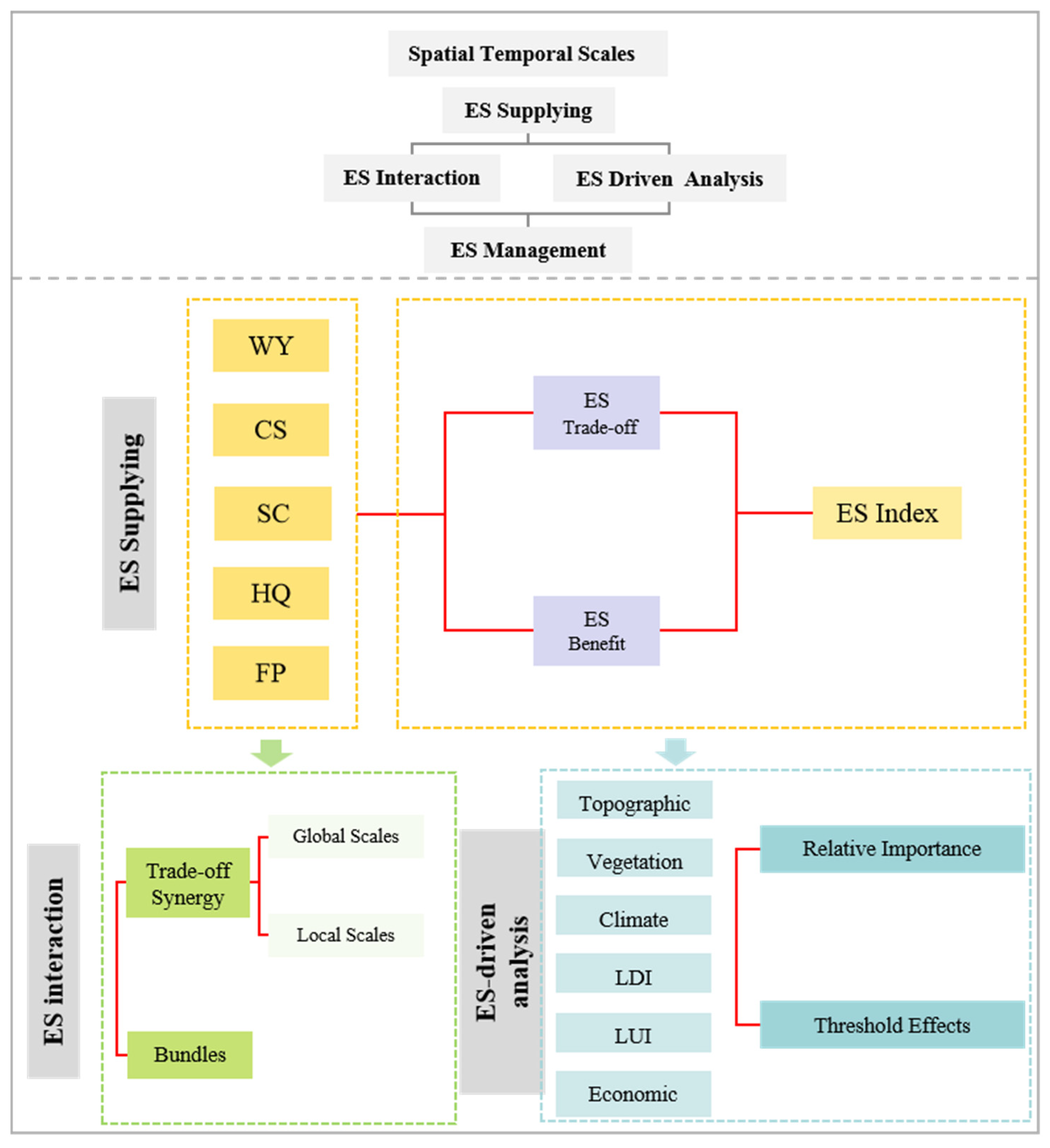
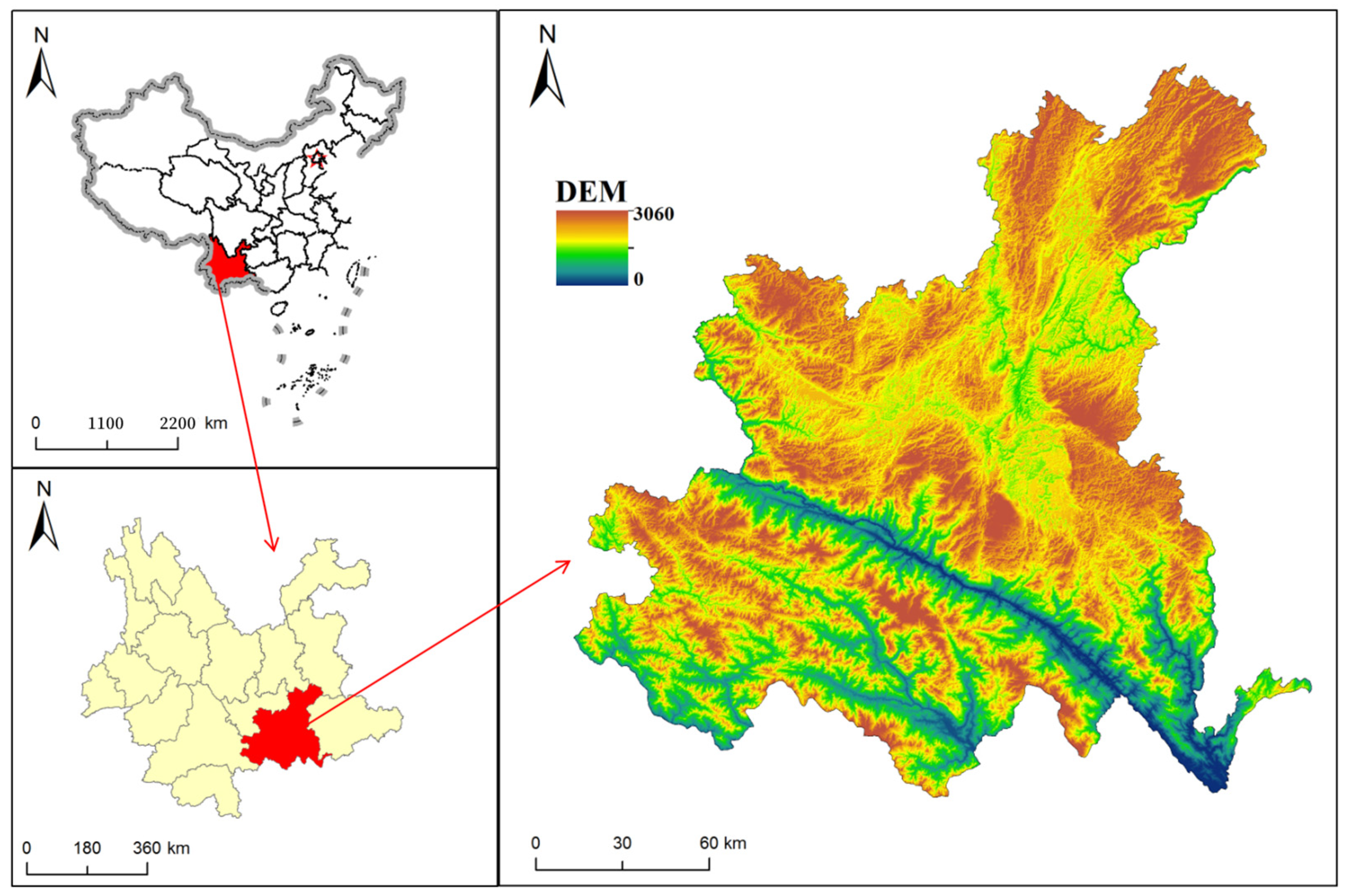

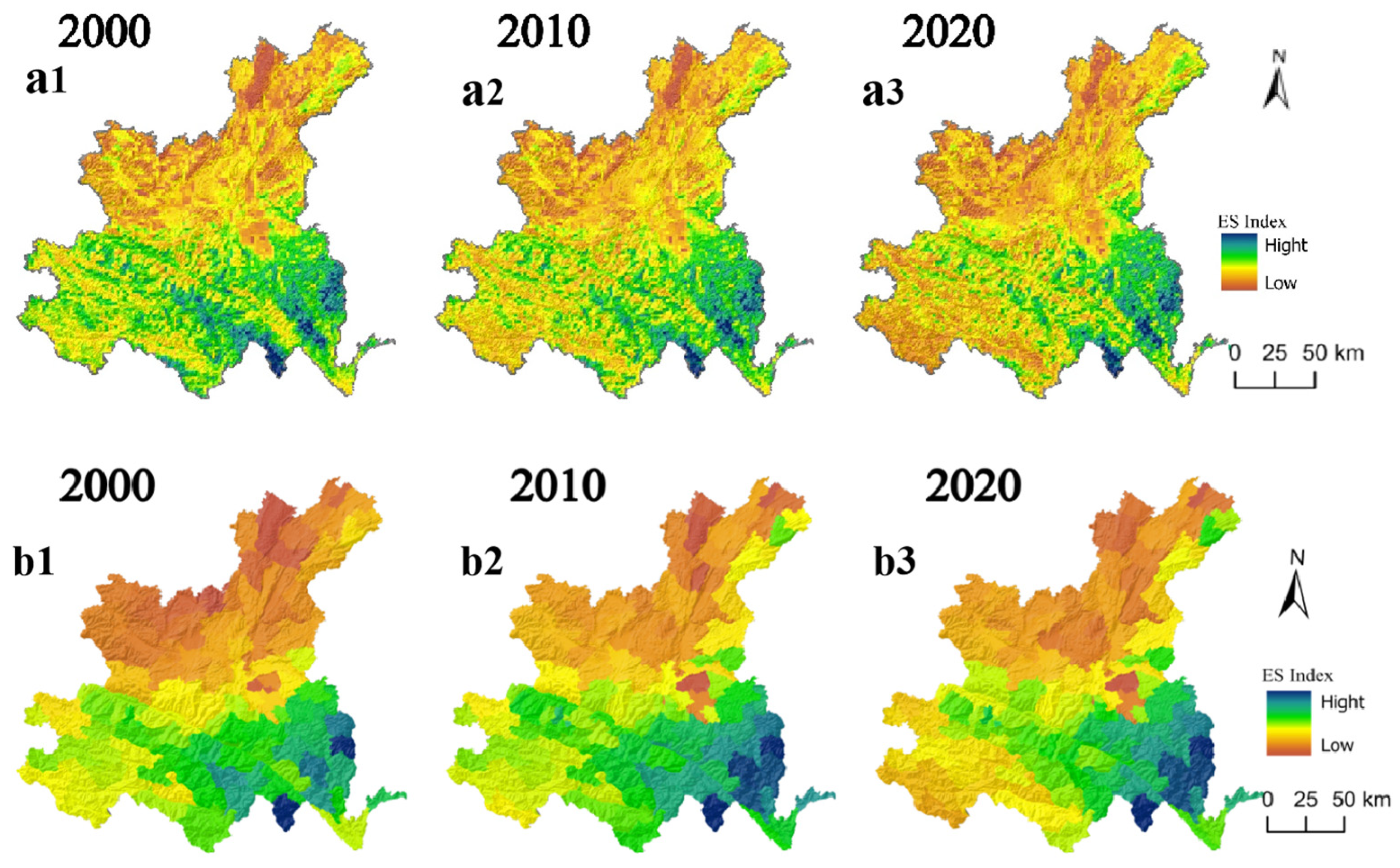


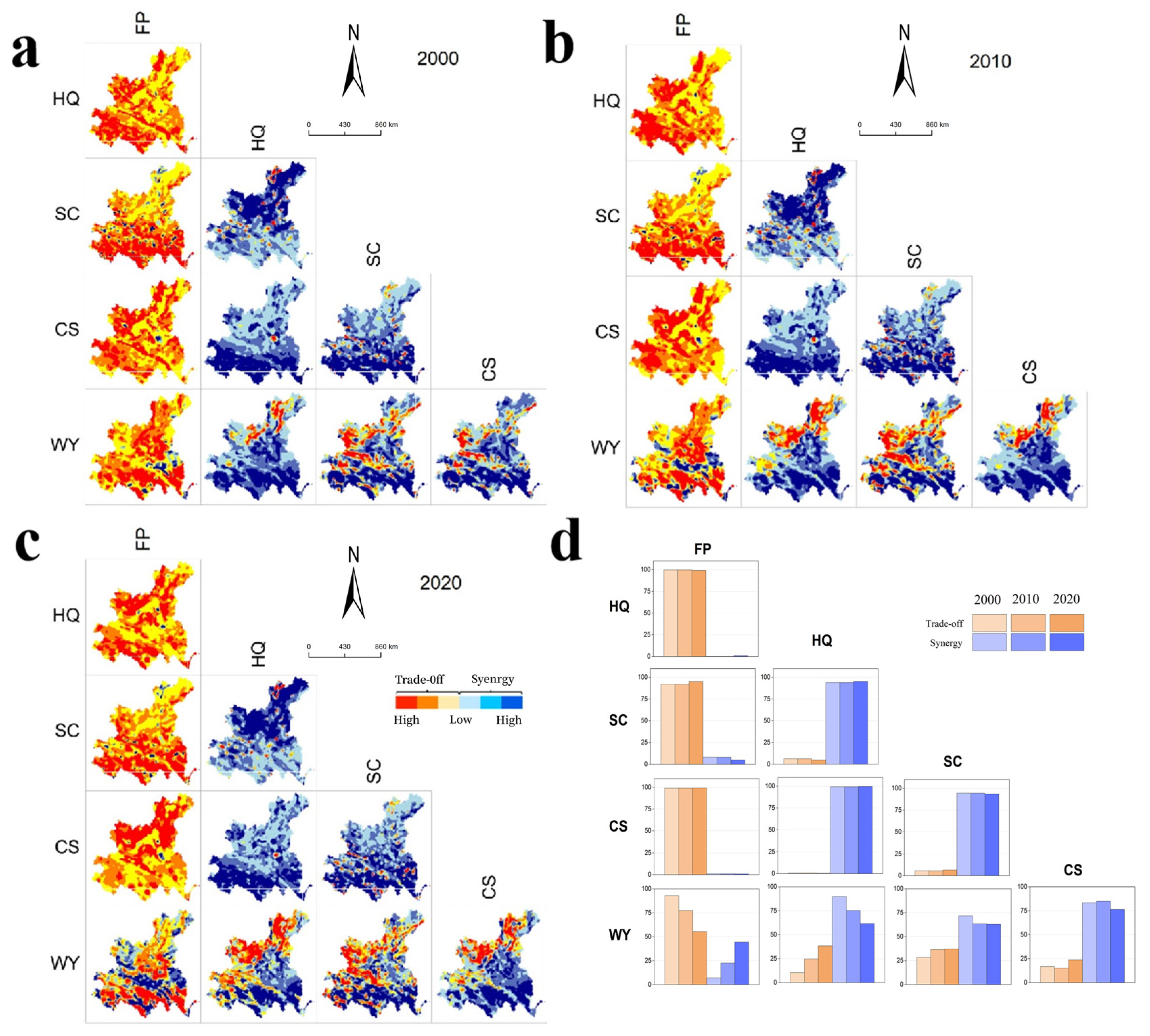
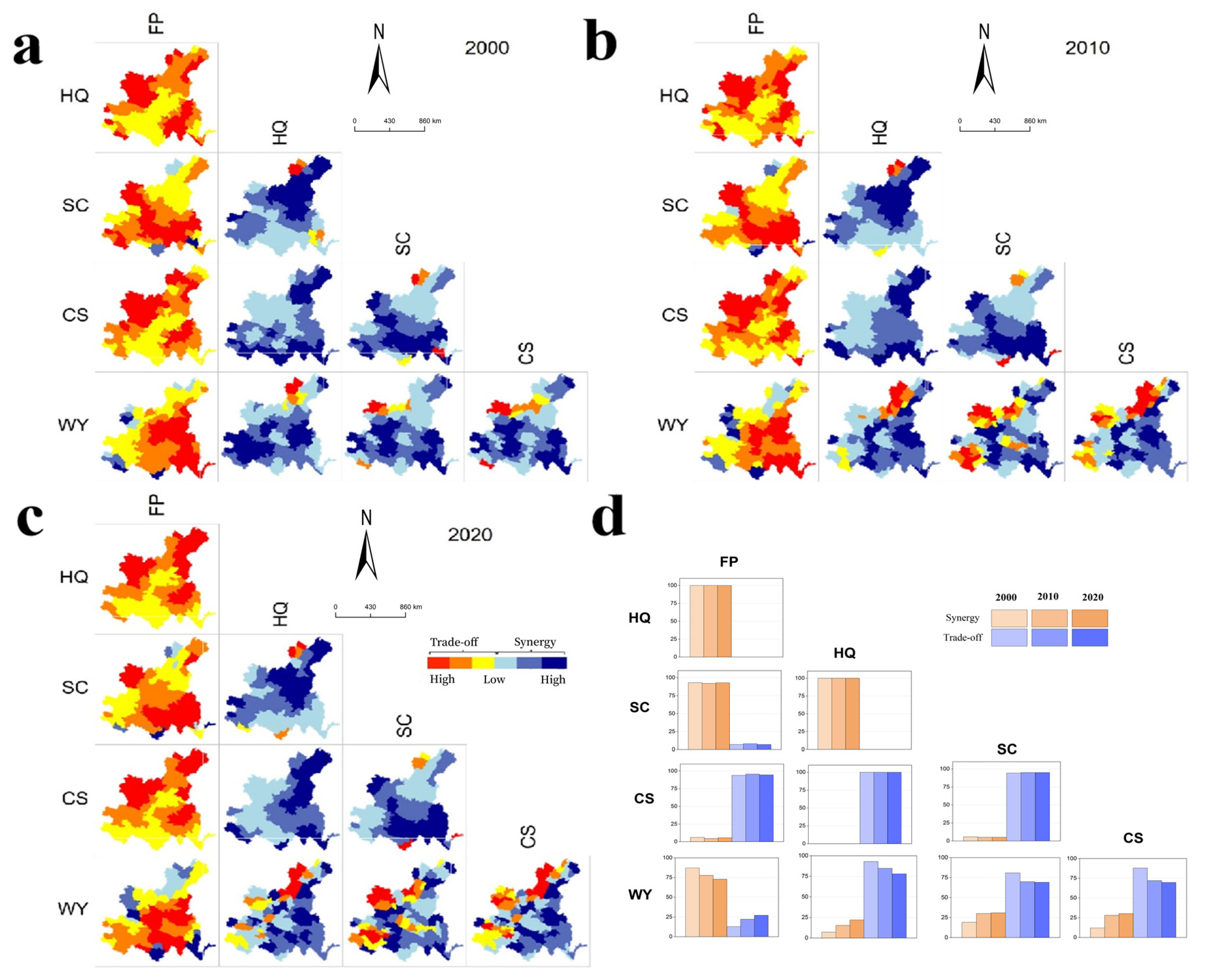

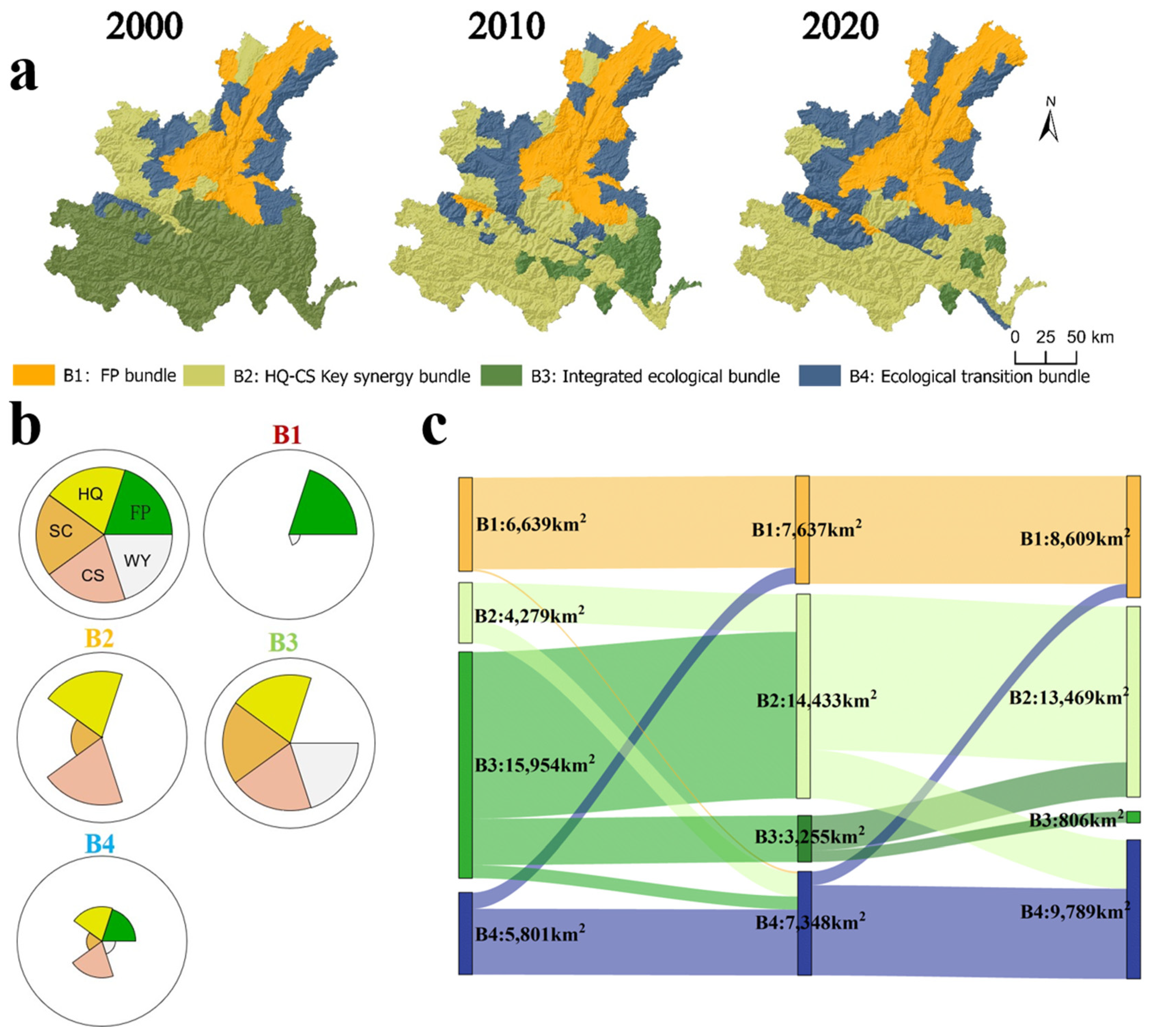
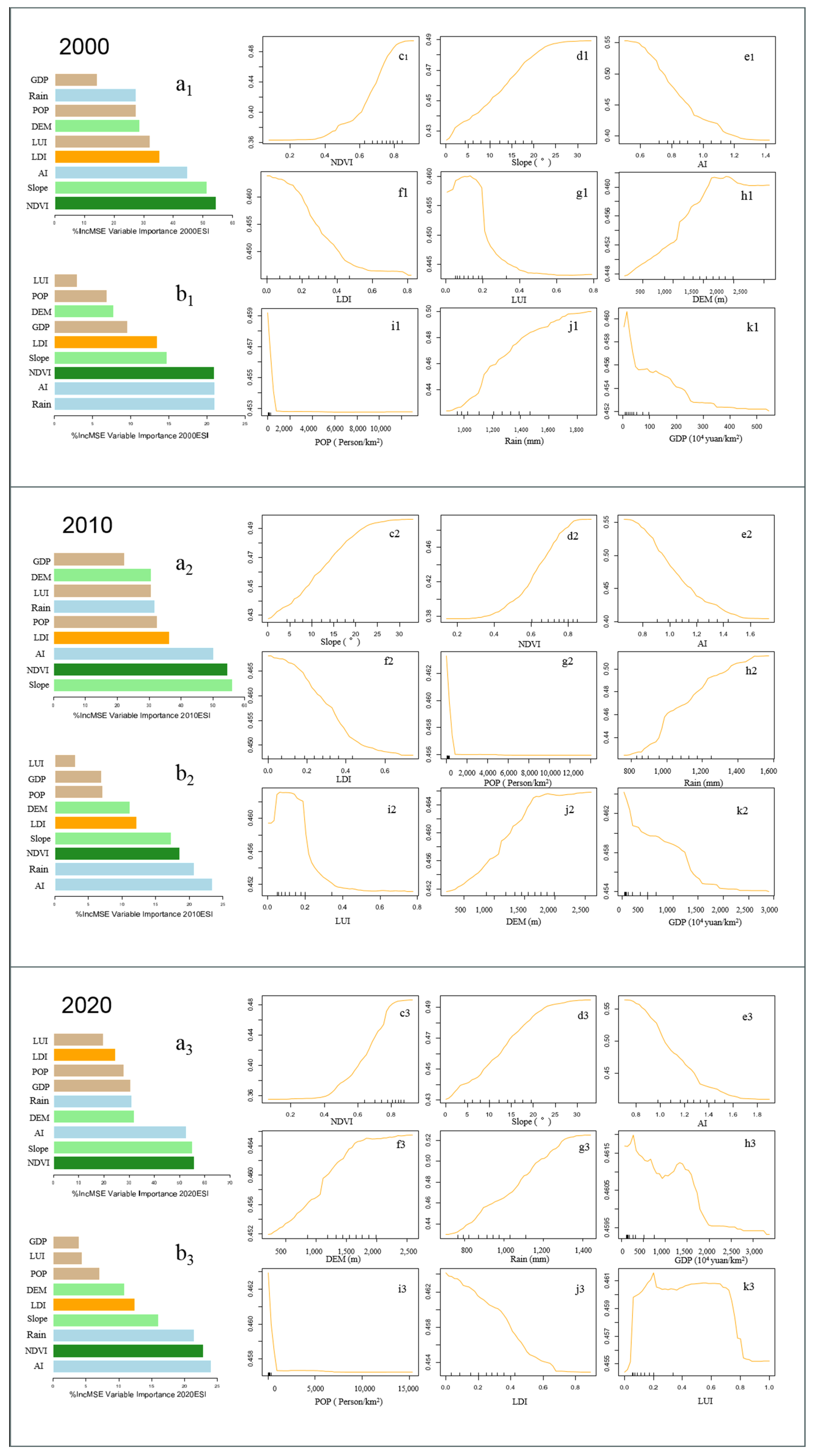
| Data | Spatial Resolution (m) | Data Source/Processing |
|---|---|---|
| Land use/land cover (LULC) | 30 | Resource and Environmental Science Data Center, Chinese Academy of Sciences (https://www.resdc.cn/, accessed on 1 January 2024) |
| Digital elevation model (DEM) | 30 | Geospatial Data Cloud (http://www.gscloud.cn/, accessed on 1 January 2024) |
| Slope | 30 | Geospatial Data Cloud (http://www.gscloud.cn/, accessed on 1 January 2024) |
| Precipitation | 30 | A Big Earth Data Platform for Three Poles (https://www.geocri.org/data-repositories-tg/big-earth-data-platform-for-three-poles, accessed on 1 January 2024) |
| Evapotranspiration | 1000 | A Big Earth Data Platform for Three Poles (https://www.geocri.org/data-repositories-tg/big-earth-data-platform-for-three-poles, accessed on 1 January 2024) |
| Soil types, soil texture, and organic carbon content | 1000 | National Tibetan Plateau Science Data Center (https://data.tpdc.ac.cn/, accessed on 1 January 2024) |
| Normalized difference vegetation index (NDVI) | 1000 | Resource and Environmental Science Data Center, Chinese Academy of Sciences (https://www.resdc.cn/, accessed on 1 January 2024) |
| GDP | / | Statistical yearbooks of the counties and districts of Honghe Prefecture |
| Food yield | / | Statistical yearbooks of the counties and districts of Honghe Prefecture |
| Population density | / | Statistical yearbooks of the counties and districts of Honghe Prefecture |
| Category | Ecosystem Service | Abbreviation | Description | Methodology |
|---|---|---|---|---|
| Supporting service | Habitat quality | HQ | Ecosystems possess the capacity to furnish environments conducive to the sustainability of both individual organisms and their collective populations | InVEST model |
| Provisioning service | Water yield | WY | The annual yield of water | InVEST model |
| Food production | FP | The yield of staple food crops | Measurable proxies | |
| Regulating service | Carbon storage | CS | The quantity of carbon sequestered within terrestrial ecological systems | InVEST model |
| Soil conservation | SC | Quantification of soil retention | InVEST model |
| Type | Group | Driving Factor | Code | Reference |
|---|---|---|---|---|
| Natural environment | Climate | Aridity index | AI | [47] |
| Annual average precipitation | Rain | [48] | ||
| Topography | Slope gradient | Slope | [49] | |
| Digital elevation model | DEM | [43] | ||
| Vegetation | Normalized difference vegetation index | NDVI | [50] | |
| Landscape pattern | Landscape disturbance index | LDI | [51] | |
| Socioeconomic system | Social economy | Gross domestic product | GDP | [48] |
| Social economy | Population density | POP | [52] | |
| Land use | Land use | LUI | [53] |
Disclaimer/Publisher’s Note: The statements, opinions and data contained in all publications are solely those of the individual author(s) and contributor(s) and not of MDPI and/or the editor(s). MDPI and/or the editor(s) disclaim responsibility for any injury to people or property resulting from any ideas, methods, instructions or products referred to in the content. |
© 2025 by the authors. Licensee MDPI, Basel, Switzerland. This article is an open access article distributed under the terms and conditions of the Creative Commons Attribution (CC BY) license (https://creativecommons.org/licenses/by/4.0/).
Share and Cite
Chen, X.; Cui, M.; Yang, Q.; Xu, Z.; Liu, S.; Zhang, L.; Li, G.; Liu, Y. Study on the Spatiotemporal Heterogeneity and Threshold Effects of Ecosystem Services in Honghe Prefecture, Yunnan Province. Remote Sens. 2025, 17, 566. https://doi.org/10.3390/rs17040566
Chen X, Cui M, Yang Q, Xu Z, Liu S, Zhang L, Li G, Liu Y. Study on the Spatiotemporal Heterogeneity and Threshold Effects of Ecosystem Services in Honghe Prefecture, Yunnan Province. Remote Sensing. 2025; 17(4):566. https://doi.org/10.3390/rs17040566
Chicago/Turabian StyleChen, Xinjun, Ming Cui, Qiankun Yang, Zihan Xu, Shuangyan Liu, Liheng Zhang, Guijing Li, and Yuguo Liu. 2025. "Study on the Spatiotemporal Heterogeneity and Threshold Effects of Ecosystem Services in Honghe Prefecture, Yunnan Province" Remote Sensing 17, no. 4: 566. https://doi.org/10.3390/rs17040566
APA StyleChen, X., Cui, M., Yang, Q., Xu, Z., Liu, S., Zhang, L., Li, G., & Liu, Y. (2025). Study on the Spatiotemporal Heterogeneity and Threshold Effects of Ecosystem Services in Honghe Prefecture, Yunnan Province. Remote Sensing, 17(4), 566. https://doi.org/10.3390/rs17040566






